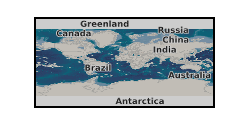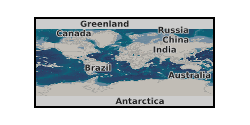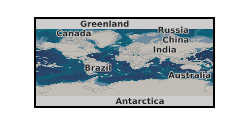Carbon
Type of resources
Available actions
Topics
Keywords
Contact for the resource
Provided by
Years
Formats
Representation types
Update frequencies
Resolution
-
The International Satellite Land Surface Climatology Project, Initiative II (ISLSCP II) is a follow on project from The International Satellite Land Surface Climatology Project (ISLSCP). ISLSCP II had the lead role in addressing land-atmosphere interactions - process modelling, data retrieval algorithms, field experiment design and execution, and the development of global data sets. The ISLSCP II dataset contains comprehensive data over the 10 year period from 1986 to 1995, from the International Satellite Land Surface Climatology Project (ISLSCP). This dataset contains: *Sea-Air CO2 Flux and Sea-Air CO2 Partial Pressure *CO2 Consumption by Continental Erosion and Riverine Fluxes of Carbon and Sediments to the Oceans *CO2 Emissions *Energy Flux Measurement *Atmospheric CH4 Data *Atmospheric CO2 Data *Global Net Primary Productivity The data are mapped to consistent grids (0.5 x 0.5 degrees for topography, 1 x 1 degrees for meteorological parameters). Some data have a grid size of 0.25 x 0.25 degrees. The temporal resolution for most data sets is monthly (however a few are at finer resolution - 3 hourly). This dataset is public.
-

A dataset of DOC and DBC concentrations from 78 sampling locations in South American rivers (surface waters).
-

In March 2010, the Scottish CCS (Carbon Capture & Storage) Consortium began an extensive Front End, Engineering and Design (FEED) study to assess what would be required from an engineering, commercial and regulatory, perspective in order to progress the CCS demonstration project at Longannet Power station in Scotland through to construction. The study yielded invaluable knowledge and the resulting material are available for download here. This section of the report provides a summary of key decisions and design changes made during FEED that have resulted from the development of the End-to-End solution and the design works conducted by each of the Consortium Partners. The information described in this section captures the design decisions and changes that have had the most prominent impact on the End-to-End Basis of Design. For each key design change/decision, the background, options considered and the final outcome is described. The ScottishPower CCS Consortium Decision Register can be found in PDFs . The appropriate summary section from the Feed Close Out Report can be downloaded as a PDF (Key FEED decisions.pdf). The main text of the FEED Close Out Report, together with the supporting appendix for this section can be downloaded as PDF files. Note this dataset is a duplicate of the reports held at the National Archive which can be found at the following link - http://webarchive.nationalarchives.gov.uk/20121217150421/http://decc.gov.uk/en/content/cms/emissions/ccs/ukccscomm_prog/feed/scottish_power/feed_decisions/feed_decisions.aspx
-

In March 2010, the Scottish CCS (Carbon Capture & Storage) Consortium began an extensive Front End, Engineering and Design (FEED) study to assess what would be required from an engineering, commercial and regulatory, perspective in order to progress the CCS demonstration project at Longannet Power station in Scotland through to construction. The study yielded invaluable knowledge and the resulting material are available for download here. This section of the report provides details on the organisation and management of the design as well as key design information for the End-to-End CCS chain. This includes the following: Organisation of the design teams; The End-to-End Basis of Design; The design life; The End-to-End CCS chain process; Piping and instrumentation diagrams; Plant and site layout drawings for the various sites; Equipment; Plant and equipment specifications; Subsurface engineering design reports; No attempt has been made to generalise design data. All of the design information presented is specific to the ScottishPower Consortium Project and has been presented to provide an insight into the development of the End-to-End CCS solution. The FEED design study was based on the Outline Solution developed by the Consortium prior to FEED. The Outline Solution was a conceptual design for the End-to-End CCS chain that was considered to be technically feasible within the constraints of the knowledge available at the time. It included a series of optioneering studies to identify the preferred design for this particular project. During FEED, the Outline Solution design was developed in greater detail to reduce the cost and technical uncertainty, and consequently reduce the financial, programme and technical risks prior to commencing the implementation stage of the project. It must be stressed that a FEED study is carried out to develop a design to the degree that the technical and programme risks are reduced to the agreed limits to better inform the project cost estimate. The current status is that the design has been progressed as far as is practicable within the time and cost constraints of the FEED study. Specifications and datasheets for major equipment have been developed in order that they can be issued to potential suppliers during the implementation phase of the project. The FEED study identified further activities that cannot be performed at the FEED stage of the project but which have been recorded as actions for further investigation during the implementation stage. The FEED study has advanced the development of the application of CCS technology considerably. Though research and conceptual studies are essential to the development of any new technology, they cannot identify many of the difficult design issues that are identified and addressed during a FEED study. Similarly the progress from FEED to the implementation phase is expected to present further challenges for a project of this novel nature. However, the advantage of a FEED study is that the main issues that could present high cost or programme difficulties or even potential 'show stoppers' should already have been identified and, where possible, addressed. Key decisions and design changes taken during the FEED study are explained in Section 11 of the report. The FEED study indicates that CCS remains technically feasible. The appropriate summary section from the Feed Close Out Report can be downloaded as a PDF (Design.pdf). The main text of the FEED Close Out Report, together with the supporting appendix for this section can be downloaded as PDF files.
-

During 2010-11, as part of the Carbon Capture & Storage (CCS) Demonstration Competition process, E.ON undertook a Front End Engineering Design (FEED) study for the development of a commercial scale CCS demonstration plant at Kingsnorth in Kent, South East England. The study yielded invaluable knowledge and the resulting material is available for download here. This chapter is devoted to the transportation and injection infrastructure requirements of the Kingsnorth Carbon Capture and Storage development. This encompasses a 36 inch (outside diameter) pipeline which runs onshore for approx 10 km and offshore in the Southern North Sea for 260 km, a platform in the vicinity of the Hewett field location, and appropriate facilities both for the conditioning of CO2 before pipeline entry and the processing of the CO2 stream prior to injection into the sequestration site. The chapter highlights in particular the following areas:- Critical assumptions; Platform Concept Selection; Transport Solution Selection; Pipeline Key Issues; Pipeline Pre-Commissioning; Temperature; Emergency Shutdown; Personnel Safety; Venting; Flow Assurance Modelling. Throughout the execution of the work described in this chapter significant opportunity was taken to ensure that the interfaces from capture (and compression) to pipeline/platform and to wells/storage were managed closely. This was achieved by cross system interface management meetings organized to consider interface issues and to compare issues raised in separate HAZIDs. The purpose of conceptual design has been to identify the problems to be addressed comprehensively by the next stage of FEED and this suite of reports provides valuable insights to the challenges faced. All aspects of establishing an agreed philosophy for design and operation of a storage and transport system for CCS begin with understanding what the initial CO2 flow conditions will be at the interface between the well perforations and the reservoir (i.e. at the sandstone face at the bottom of the well). Further supporting documents for chapter 6 of the Key Knowledge Reference Book can be downloaded.
-

During 2010-11, as part of the Carbon Capture & Storage (CCS) Demonstration Competition process, E.ON undertook a Front End Engineering Design (FEED) study for the development of a commercial scale CCS demonstration plant at Kingsnorth in Kent, South East England. The study yielded invaluable knowledge and the resulting material is available for download here. This chapter contains design philosophy documents which were produced to ensure a common approach to the design of all aspects of the CCS project, addressing overall project lifecycle and the interface between the Carbon Capture Plant and the Power Station. Some of the key issues concerning the design and integration of a CCS development are: Power plants have been designed for many years to operate flexibly in response to the demands of the electricity network. The CCS plant technology is closer to process plant technology which is not usually designed for such flexible operation, and this will provide a key challenge during the detailed design process to provide the required flexibility of operation; Assessment of various cooling technologies for the power station and carbon capture plant shows that direct water cooling is the Best Available Technology in terms of Environmental Impact; Significant parts of the existing cooling water infrastructure can be re-used; There is potential to advantageously interface steam and cooling systems between the power plant and CCS plant; Venting, and the consequent cooling, of CO2 for pressure relief or operational reasons raises issues with lack of buoyancy and dispersion which require significant further work. Further supporting documents for chapter 4 of the Key Knowledge Reference Book can be downloaded. Note this dataset is a duplicate of the reports held at the National Archive which can be found at the following link - http://webarchive.nationalarchives.gov.uk/20121217150421/http://decc.gov.uk/en/content/cms/emissions/ccs/ukccscomm_prog/feed/e_on_feed_/project_design/project_design.aspx
-

Carbon and oxygen isotopic composition of planktic foraminifera spanning the early and middle Eocene succession recovered from borehole 16/28-Sb01. For description of this sedimentary sequence see Haughton et al. 2005. Petroleum Geology: North-West Europe and Global Perspectives, Proceedings of the 6th Petroleum Geology Conference, 1077–1094.
-

The potential for leakage of CO2 from a storage reservoir into the overlying marine sediments and into the water column and the impacts on benthic ecosystems are major challenges associated with Carbon Capture and Storage (CCS) in subseafloor reservoirs. A field-scale controlled CO2 release experiment was conducted in shallow, unconsolidated marine sediments. Changes were monitored of the chemical composition of the sediments and overlying water column before, during and up to 1 year after the 37-day long CO2 release from May 2012 to May 2013 in Ardmucknish Bay. Meiofaunal samples were collected and meiofauna higher taxa and the nematodes species (where possible) were identified by Plymouth Marine Laboratory. This dataset was collected under the program QICS (Quantifying and monitoring environmental impacts of geological carbon storage) which was funded by the Natural Environment Research Council (NERC), with support from the Scottish Government. The results are contained in an Excel file. QICS project website: www.bgs.ac.uk/qics/home.html. This data is currently under embargo until publication of the dataset in research article (estimated end of 2015).
-

The UK government is committed to sharing the knowledge from the UK CCS projects. Under the 2013/2014 Front End Engineering and Design (FEED) contracts, the Peterhead (Goldeneye) and White Rose CCS projects delivered 86 reports. Under FEED, the completed reports are defined as Key Knowledge Deliverables (KKDs). The reports will enable both the Peterhead and White Rose projects to share the knowledge and learning acquired on their respective CCS projects. These Key Knowledge Deliverables from these FEED studies will cover many aspects of delivering a large scale commercial CCS project. This will include: commercial and financing arrangements; programme and risk management; consents and permitting; technical design, engineering and integration; health and safety; and lessons learnt. The KKDs will be published by DECC during 2015 and 2016. The reports can be accessed from https://www.gov.uk/government/collections/carbon-capture-and-storage-knowledge-sharing.
-

During 2010-11, as part of the Carbon Capture & Storage (CCS) Demonstration Competition process, E.ON undertook a Front End Engineering Design (FEED) study for the development of a commercial scale CCS demonstration plant at Kingsnorth in Kent, South East England. The study yielded invaluable knowledge and the resulting material is available for download here. This chapter presents the Health and Safety Reports produced during the current FEED stage. HAZID/ENVID studies were carried out for the following sections of the project: Kingsnorth Power Plant (impact on and from CCS); Kingsnorth CO2 capture and compression plant; CO2 Pipeline (On and Offshore); Kingsnorth CO2 Injection Platform; Wells and Reservoirs. The results of the HAZID studies for the power plant and capture and compression plant are recorded in the 'HAZID Report' and 'HAZID Report Addendum' in this Chapter. The pipeline and platform HAZID is in section 6 and the wells and reservoirs HAZID in section 7. Other reviews, such as SIMOPS (Simultaneous Operations) studies have been carried out. A review of Major Accident Hazards for the pipeline has been undertaken and the outcome is described in the report 'ALARP Review Report for Genesis Scope of Work'. Design Risk Assessments (DRAs) were carried out by the design teams, with support from the Safety Consultant. DRAs were qualitative rather than quantitative, due to the early stage of design within FEED. The DRAs are collated and summarised in the 'CDM Design Risk Register'. A draft Pre-Construction Safety Report has been produced to further inform the design process, and enhance our understanding of the significant hazards, both safety and environmental, associated with these processes. This overall approach to Health and Safety is set out in more detail in the 'Health and Safety Design Philosophy' Further supporting documents for chapter 8 of the Key Knowledge Reference Book can be downloaded.
 NERC Data Catalogue Service
NERC Data Catalogue Service